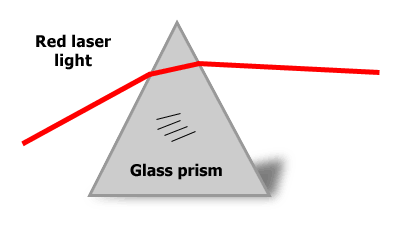Explore challenges and solutions in AI chip development
Optics For Kids - About Lasers
Click on the topics to start learning!
Splitting Light
Did you know there is something called "white light"?
Regular light from the sun or from a light bulb really contains all the colors of the rainbow. But you have to split it up to see this.
Can you split light???
YES! You can split up white light into its colors with a prism (raindrops act like tiny prisms when they make a rainbow in the sky, and a CD can break the light up into colors because it has fine grooves like a diffraction grating or a hologram).

So what is a laser?


A laser is a special source of light of only one pure color (or WAVELENGTH). You can't break up laser light into other colors.
What can lasers do?

They can FOCUS!
Lasers can be focused to a very small spot and can shine for long distances without spreading out very much (unlike a flashlight which spreads out a lot).
They generate ENERGY!
The spot contains a lot of energy - so much that some lasers can cut through thick metal (and smaller ones are used as scalpels in some kinds of surgery).


They can carry INFORMATION!
Lower-power laser systems can be used to send and pick up information. For example, the product code scanner in a supermarket uses a laser, lenses, rotating mirrors, and a computer to "read" bar codes from products. And the tiny laser in a CD player reads EVEN tinier bumps and holes that record the music like Morse Code (bumps and holes are like dots and dashes).
They can be used for COMMUNICATION!
Lasers can also send information through long threads of glass called OPTICAL FIBERS. A single laser can send thousands of phone conversations through a fiber at the SAME TIME.


They make HOLOGRAMS!
Lasers are also used to make 3-D pictures called HOLOGRAMS (some engineers are working on moving holograms, so someday we may have AMAZING 3-D TV pictures - learn more about holograms at holocenter.org).
IMPORTANT SAFETY NOTE: PLEASE BE CAREFUL WITH LASERS.
Even low-power laser pointers can cause injury if shined directly into eyes. Children should be supervised or be old enough to understand the safety issues and handle these devices safely.






